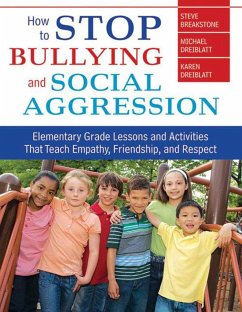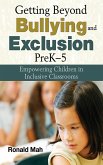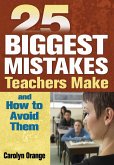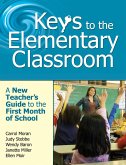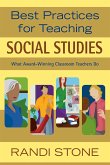Steve Breakstone, Michael Dreiblatt, Karen Dreiblatt
How to Stop Bullying and Social Aggression
Elementary Grade Lessons and Activities That Teach Empathy, Friendship, and Respect
16,99 €
inkl. MwSt.
Versandfertig in über 4 Wochen

8 °P sammeln
Steve Breakstone, Michael Dreiblatt, Karen Dreiblatt
How to Stop Bullying and Social Aggression
Elementary Grade Lessons and Activities That Teach Empathy, Friendship, and Respect
- Broschiertes Buch
- Merkliste
- Auf die Merkliste
- Bewerten Bewerten
- Teilen
- Produkt teilen
- Produkterinnerung
- Produkterinnerung
Encourage respectful, positive social behavior inall...
Andere Kunden interessierten sich auch für
![Getting Beyond Bullying and Exclusion, PreK-5 Getting Beyond Bullying and Exclusion, PreK-5]() Ronald MahGetting Beyond Bullying and Exclusion, PreK-516,99 €
Ronald MahGetting Beyond Bullying and Exclusion, PreK-516,99 €![Secrets to Success for Science Teachers Secrets to Success for Science Teachers]() Ellen KottlerSecrets to Success for Science Teachers18,99 €
Ellen KottlerSecrets to Success for Science Teachers18,99 €![Secrets to Success for Social Studies Teachers Secrets to Success for Social Studies Teachers]() Ellen KottlerSecrets to Success for Social Studies Teachers16,99 €
Ellen KottlerSecrets to Success for Social Studies Teachers16,99 €![25 Biggest Mistakes Teachers Make and How to Avoid Them 25 Biggest Mistakes Teachers Make and How to Avoid Them]() Carolyn Orange25 Biggest Mistakes Teachers Make and How to Avoid Them16,99 €
Carolyn Orange25 Biggest Mistakes Teachers Make and How to Avoid Them16,99 €![Keys to the Elementary Classroom Keys to the Elementary Classroom]() Carrol MoranKeys to the Elementary Classroom16,99 €
Carrol MoranKeys to the Elementary Classroom16,99 €![Best Practices for Teaching Social Studies Best Practices for Teaching Social Studies]() Randi StoneBest Practices for Teaching Social Studies16,99 €
Randi StoneBest Practices for Teaching Social Studies16,99 €![The Developing Brain The Developing Brain]() Marilee SprengerThe Developing Brain16,99 €
Marilee SprengerThe Developing Brain16,99 €-
-
-
Encourage respectful, positive social behavior inall...
Hinweis: Dieser Artikel kann nur an eine deutsche Lieferadresse ausgeliefert werden.
Hinweis: Dieser Artikel kann nur an eine deutsche Lieferadresse ausgeliefert werden.
Produktdetails
- Produktdetails
- Verlag: Skyhorse Publishing
- Seitenzahl: 208
- Erscheinungstermin: 9. Oktober 2012
- Englisch
- Abmessung: 278mm x 216mm x 15mm
- Gewicht: 794g
- ISBN-13: 9781620872185
- ISBN-10: 1620872188
- Artikelnr.: 35428211
- Herstellerkennzeichnung
- Produktsicherheitsverantwortliche/r
- Europaallee 1
- 36244 Bad Hersfeld
- gpsr@libri.de
- Verlag: Skyhorse Publishing
- Seitenzahl: 208
- Erscheinungstermin: 9. Oktober 2012
- Englisch
- Abmessung: 278mm x 216mm x 15mm
- Gewicht: 794g
- ISBN-13: 9781620872185
- ISBN-10: 1620872188
- Artikelnr.: 35428211
- Herstellerkennzeichnung
- Produktsicherheitsverantwortliche/r
- Europaallee 1
- 36244 Bad Hersfeld
- gpsr@libri.de
Steve Breakstone, co-founder of Balance Educational Services, LLC, is a specialist in student discipline, bullying and violence prevention, behavior management and effective communication styles. During his dynamic workshops, he uses his theatrical experience to role-play serious realities such as being bullied, being the subject of rumors or being shunned by cliques. Steve is an expert in the Individuals with Disabilities Education Improvement Act (IDEA 2004), Section 504 of the Rehabilitation Act and the No Child Left Behind Act, offering easy to understand seminars to teachers, administrators and attorneys. Steve has served as the Director of Northstar Community Alliance where he worked to prevent and reduce substance abuse. He has also worked to prevent domestic abuse as the Youth and Community Educator with Project Against Violent Encounters. Steve is a past facilitator with FATHERTIME, a parenting program, and is a trained mediator. In the late 1980s, Steve and his dog, Dixie, walked 3000 miles from New Orleans to Washington State. He is the author of the book Washington WALKABOUT, which examines the experiences of a man with developmental disabilities as he and Steve walked 1,300 miles around the state of Washington, promoting the capabilities of people with disabilities. Steve lives on 30 acres in Vermont with nature photographer Jane Glesne, and their cat.
Acknowledgments
About the Authors
Introduction
1. "Same Page" Understanding of Violence, Respect, and Bullying
Defining Violence
What Is Bullying and Respect?
Ground Rules
Statistics and Studies
2. Solving Problems Peacefully and Resolving Conflicts Respectfully
The Five Steps
Statistics and Studies
3. Creating Empathy
What Makes You Feel....?
Emotional Statues: Recognizing Body Language
Statistics and Studies
Unit Test: Chapters 1-3
4. Emotional Control and Anger Management
Guided Visualizations and Anger Monster Poster
Feeling Clouds and Charades: Expressing Feelings in Pro-Social Ways
Deep Breathing and Positive Affirmations
ABCD Exercise
Statistics and Studies
5. Teaching Assertiveness
Teaching Assertive Communication
Handshaking: Using the Qualities of Assertiveness
Recognizing Assertive, Aggressive, and Passive Communication Styles
Practicing Assertive Statements
Assertiveness Role-Plays
Statistics and Studies
6. Responding to a Bully
Bully Proofing Plan of Action
Role-Playing the Bully Proofing Plan of Action
Statistics and Studies
Unit Test: Chapters 4-6
7. The Power of Bystanders
What¿s a Bystander to Do?
Tattling Versus Teling, A.K.A. Ratting Versus Reporting
Statistics and Studies
8. Playful Teasing Versus Hurtful Taunting
Defining Playful Teasing Versus Hurtful Taunting
You Be the Judge
Statistics and Studies
9. Making Friends: Strategies to Resist Social Aggression
Definition of Social Aggression
Likes and Yikes: Determining Friendship Qualities
Personal Boundaries
Finding New Friends
Statistics and Studies
Unit Test: Chapters 7-9
Final Test: Chapters 1-9
Epilogue
Resources
Resource A: Problems and Conflicts to Resolve
Resource B: Assertive Statements
Resource C: Assertive Communication Scenarios
Resource D: Lesson Outlines
References
About the Authors
Introduction
1. "Same Page" Understanding of Violence, Respect, and Bullying
Defining Violence
What Is Bullying and Respect?
Ground Rules
Statistics and Studies
2. Solving Problems Peacefully and Resolving Conflicts Respectfully
The Five Steps
Statistics and Studies
3. Creating Empathy
What Makes You Feel....?
Emotional Statues: Recognizing Body Language
Statistics and Studies
Unit Test: Chapters 1-3
4. Emotional Control and Anger Management
Guided Visualizations and Anger Monster Poster
Feeling Clouds and Charades: Expressing Feelings in Pro-Social Ways
Deep Breathing and Positive Affirmations
ABCD Exercise
Statistics and Studies
5. Teaching Assertiveness
Teaching Assertive Communication
Handshaking: Using the Qualities of Assertiveness
Recognizing Assertive, Aggressive, and Passive Communication Styles
Practicing Assertive Statements
Assertiveness Role-Plays
Statistics and Studies
6. Responding to a Bully
Bully Proofing Plan of Action
Role-Playing the Bully Proofing Plan of Action
Statistics and Studies
Unit Test: Chapters 4-6
7. The Power of Bystanders
What¿s a Bystander to Do?
Tattling Versus Teling, A.K.A. Ratting Versus Reporting
Statistics and Studies
8. Playful Teasing Versus Hurtful Taunting
Defining Playful Teasing Versus Hurtful Taunting
You Be the Judge
Statistics and Studies
9. Making Friends: Strategies to Resist Social Aggression
Definition of Social Aggression
Likes and Yikes: Determining Friendship Qualities
Personal Boundaries
Finding New Friends
Statistics and Studies
Unit Test: Chapters 7-9
Final Test: Chapters 1-9
Epilogue
Resources
Resource A: Problems and Conflicts to Resolve
Resource B: Assertive Statements
Resource C: Assertive Communication Scenarios
Resource D: Lesson Outlines
References
Acknowledgments
About the Authors
Introduction
1. "Same Page" Understanding of Violence, Respect, and Bullying
Defining Violence
What Is Bullying and Respect?
Ground Rules
Statistics and Studies
2. Solving Problems Peacefully and Resolving Conflicts Respectfully
The Five Steps
Statistics and Studies
3. Creating Empathy
What Makes You Feel....?
Emotional Statues: Recognizing Body Language
Statistics and Studies
Unit Test: Chapters 1-3
4. Emotional Control and Anger Management
Guided Visualizations and Anger Monster Poster
Feeling Clouds and Charades: Expressing Feelings in Pro-Social Ways
Deep Breathing and Positive Affirmations
ABCD Exercise
Statistics and Studies
5. Teaching Assertiveness
Teaching Assertive Communication
Handshaking: Using the Qualities of Assertiveness
Recognizing Assertive, Aggressive, and Passive Communication Styles
Practicing Assertive Statements
Assertiveness Role-Plays
Statistics and Studies
6. Responding to a Bully
Bully Proofing Plan of Action
Role-Playing the Bully Proofing Plan of Action
Statistics and Studies
Unit Test: Chapters 4-6
7. The Power of Bystanders
What¿s a Bystander to Do?
Tattling Versus Teling, A.K.A. Ratting Versus Reporting
Statistics and Studies
8. Playful Teasing Versus Hurtful Taunting
Defining Playful Teasing Versus Hurtful Taunting
You Be the Judge
Statistics and Studies
9. Making Friends: Strategies to Resist Social Aggression
Definition of Social Aggression
Likes and Yikes: Determining Friendship Qualities
Personal Boundaries
Finding New Friends
Statistics and Studies
Unit Test: Chapters 7-9
Final Test: Chapters 1-9
Epilogue
Resources
Resource A: Problems and Conflicts to Resolve
Resource B: Assertive Statements
Resource C: Assertive Communication Scenarios
Resource D: Lesson Outlines
References
About the Authors
Introduction
1. "Same Page" Understanding of Violence, Respect, and Bullying
Defining Violence
What Is Bullying and Respect?
Ground Rules
Statistics and Studies
2. Solving Problems Peacefully and Resolving Conflicts Respectfully
The Five Steps
Statistics and Studies
3. Creating Empathy
What Makes You Feel....?
Emotional Statues: Recognizing Body Language
Statistics and Studies
Unit Test: Chapters 1-3
4. Emotional Control and Anger Management
Guided Visualizations and Anger Monster Poster
Feeling Clouds and Charades: Expressing Feelings in Pro-Social Ways
Deep Breathing and Positive Affirmations
ABCD Exercise
Statistics and Studies
5. Teaching Assertiveness
Teaching Assertive Communication
Handshaking: Using the Qualities of Assertiveness
Recognizing Assertive, Aggressive, and Passive Communication Styles
Practicing Assertive Statements
Assertiveness Role-Plays
Statistics and Studies
6. Responding to a Bully
Bully Proofing Plan of Action
Role-Playing the Bully Proofing Plan of Action
Statistics and Studies
Unit Test: Chapters 4-6
7. The Power of Bystanders
What¿s a Bystander to Do?
Tattling Versus Teling, A.K.A. Ratting Versus Reporting
Statistics and Studies
8. Playful Teasing Versus Hurtful Taunting
Defining Playful Teasing Versus Hurtful Taunting
You Be the Judge
Statistics and Studies
9. Making Friends: Strategies to Resist Social Aggression
Definition of Social Aggression
Likes and Yikes: Determining Friendship Qualities
Personal Boundaries
Finding New Friends
Statistics and Studies
Unit Test: Chapters 7-9
Final Test: Chapters 1-9
Epilogue
Resources
Resource A: Problems and Conflicts to Resolve
Resource B: Assertive Statements
Resource C: Assertive Communication Scenarios
Resource D: Lesson Outlines
References
